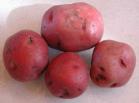Mashed, Fried, Boiled, Baked, The Potato is KING
By Jos Van Hage
 A mainstay in many vegetable gardens as well as dinner tables is the potato. This versatile tuber can be made many different ways baking, mashing, boiling or frying with some varieties better than others for the different methods of preparing them. Keeping this in mind you should plant at least 3-4 different varieties of potatoes in the garden if you have the room. Also different varieties of potatoes mature at different times and some are better ‘keepers’ than others.
A mainstay in many vegetable gardens as well as dinner tables is the potato. This versatile tuber can be made many different ways baking, mashing, boiling or frying with some varieties better than others for the different methods of preparing them. Keeping this in mind you should plant at least 3-4 different varieties of potatoes in the garden if you have the room. Also different varieties of potatoes mature at different times and some are better ‘keepers’ than others.
The earliest maturing potatoes are ‘Warba’ and ‘Eramosa’. Warbas have a very white flesh and are good for boiling and not so good for baking. As with most very early maturing varieties it is not a good potato to store for over winter. Other early maturing varieties are ‘Norgold Russet’, and ‘Norland’. Norgold Russet is very good for boiling, baking and French fries. Norland has a red skin, white flesh, is good tasting and has a good resistance to many viruses that can afflict potatoes.
The list of mid-season and late-season potato varieties is much longer. ‘Pontiac’ and ‘Sangre’ both are red skinned and white flesh. ‘Kennebec’ and ‘Nooksack’ are white skinned and white fleshed. Russet types are those with a rough brown skin and white flesh excellent for baking and these include ‘Ranger’ and ‘Goldrush’. A favorite in our garden is the yellow fleshed ‘Yukon Gold’ which is an excellent storing potato. Another favorite is the ‘Banana Fingerling’ which has yellow flesh and white skin. They grow long and thin and are tastiest when freshly dug, sliced thinly and fried in a little bit of butter.
Growing potatoes is quite easy as they grow in most types of soil and do especially well in new gardens. For a healthy potato crop you need to start with new certified seed every year. I like to plant small seed potatoes as they do not need to be cut meaning less of a chance for rot. If you are using large seed potatoes they can be cut up making sure that each piece has at least 3-4 eyes. Let the cut up pieces air dry for a day before planting allowing them to form a slight crust on the cut edge. Tubers (seed potatoes) are planted in 4-6 inch deep furrows, 10-12 inches apart in rows 3 feet apart. The tuber can be placed with the cut side down and the eyes facing up. Cover the potatoes with 3-4 inches of soil and when the plant is 6-8 inches high hill in the potato by creating hills of soil around the potato. Hilling in potatoes will help prevent the growing potatoes from becoming green due to exposure to light. Always rotate your crops so that potatoes are not grown in the same place in the garden two years in a row. Potatoes like well drained soil with a neutral pH of 6-7. Plant in an area of the garden where they will receive full sun. For a healthy, high yielding crop water the crop regularly and fertilize with a vegetable fertilizer containing a lower first number and a higher middle number.
A common complaint when growing potatoes is scab on the potato. This is caused from the soil and can happen if you add wood ashes, fresh manure or lime to the soil. If you had scabby potatoes last year make sure that you purchase new certified seed potatoes and plant them in a new area of the garden. A product called ‘Tiger 90’ is degradable sulphur that is mixed into the soil before planting the potatoes which should help prevent scab as well as using 6-20-20 potato fertilizer.
-Jos
Previous Story - Next Story
Return to Home










